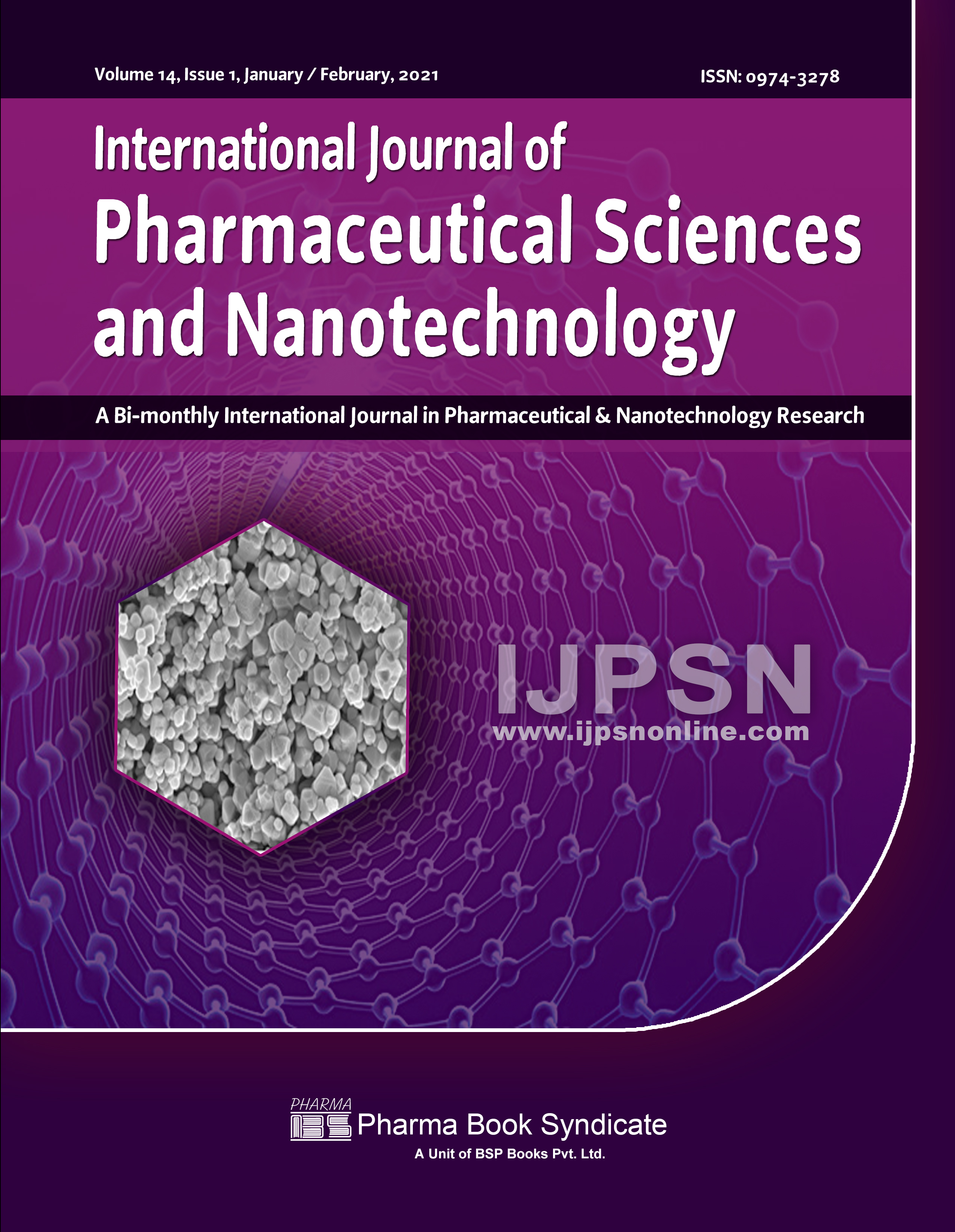Development and Evaluation of Gastrobioadhesive Glimepiride Sustained Release Matrix Tablet Using Aegle Marmelos Polysaccharide
DOI:
https://doi.org/10.37285/ijpsn.2021.14.1.5Abstract
The purpose of present study was to formulate and evaluate glimepiride gastrobioadhesive drug delivery using Aegle Marmelos polysaccharide and synthetic polymer for prolongation of gastric residence time and reduce the dosing frequency. Glimepiride matrices were prepared by direct compression method and evaluated with an aim of presenting glimepiride as sustained release for improving the patient’s compliance. A central composite design (CCD) was employed as Aegle Marmelos polysaccharide (X1) and HPMC K4M (X2) independent variables to optimize the glimepiride in terms of sustained release and gastrobioadhesive. The response (Y1) as bioadhesive strength, (Y2) percentage drug releases at 8 h and (Y3) time (t50) required to 50% drug release were measured for each trial and statistical equations with significant interaction terms were derived to predict relation. The physical properties of all formulations hardness, friability, drug content and weight variation were found within limits indicating that the prepared matrix tablets met the USP specifications. Among all the formulations, F1 formulation found to be optimized based on the criteria of attaining the maximum value of drug released Q8 of 98.58±1.12%, 18.43 g bioadhesive strength and time to 50% drug release (t50) of 6 h. An in-vitro drug release studies reveals that as concentrations of polymers increases the drug release decreases, producing sustained release of glimepiride. The release co-efficient values ‘n’ (˂0.3645) indicated that the drug release (F1) followed fickian diffusion mechanism kinetics. A glimepiride gastroadhesive matrix was developed to enhance its bioavailability by prolonging the gastric residence time with desirable release modulation for a once daily administration.
Downloads
Metrics
Keywords:
Glimepiride HCl (GLP HCl), Aegle Marmelos polysaccharide, HPMC K4M, Gastrobioadhesive drug delivery system, Matrix tabletsDownloads
Published
How to Cite
Issue
Section
References
Baumgartner S, Kristl J, Vrecer F, Vodopivec P and Zorko B (2000). Optimization of floating matrix tablets and evaluation of their gastric residence time. Int J Pharm 195(1): 125-135.
Cartensen JT (1999). Drug Stability: Principle and Practices. 2nd ed. edited by Marcel Dakker, New York, pp 538-550.
Coates J (2000). Interpretation of Infrared Spectra, a Practical Approach. John Wiley and Sons Ltd, Chichester, Meyers RA, editors. Encyclopaedia of Analytical Chemistry, pp 10815-10837.
Deshpande AA, Rhodes CT, Shah NH and Malick AW (1996). Controlled-release drug delivery systems for prolonged gastric residence: an overview. Drug Dev Ind Pharm 22(6): 531-539.
Elzayat EM, Abdel-Rahman AA, Ahmed SM, Alanazi FK, Habib WA and Sakr A (20160. Studying the impact of formulation and processing parameters on the release characteristics from hydroxypropyl methylcellulose matrix tablets of diclofenac. Acta Pol Pharm 73(2): 439-452.
Fell JT, Whitehead L and Collett JH (2000). Prolonged gastric retention using floating dosage forms. Pharm Technol 24(3): 82-90.
Gorus FK, Schuit FC and Intveld PA (1988). Interaction of sulfonylureas with pancreatic beta cells-A study with glimepiride. J Diabetes 37: 1090-1095.
Hwang SJ, Park H and Park K (1998). Gastric retentive drug delivery systems. Crit Rev Ther Drug 15(3): 243-284. Lachman L, Liberman HA and Kanig JL (1991). The theory and practices of industrial pharmacy. 3rd ed. Bombay; Varghese Publishing house, pp 297-300.
Montgomery DC (2004). Introduction to factorial deigns. Design and Analysis of Experiments. 5th ed. Wiley India Pvt. Ltd: New Delhi, pp 170-217.
Montgomery DC (2004). Introduction to factorial deigns. Design and Analysis of Experiments. 5th ed. Wiley India Pvt. Ltd, New Delhi, pp 170-217.
Moore JW (1996). Mathematical comparison of dissolution profiles. Pharma Technol 20: 64-75.
Nafee NA, Ismail FA, Boraie NA and Mortada LM (2003). Mucoadhesive buccal patches of miconazole nitrate: in vitro/in vivo performance and effect of ageing. Int J Pharm 264(1): 1-4.
Patil DN, Kulkarni AR and Patil BS (2010). Preparation and evaluation of Aegle Marmelos gum as tablet binder. Int J Pharm Biol Sci 4(4): 101-105.
Prakash P, Porwal M and Saxena A (2011). Role of natural polymers in sustained release drug delivery system: application and recent approaches. Int Res J Pharm 2(9): 6-11.
Rajan S, Gokila M, Jency P, Brindha P and Sujatha RK (2011). Antioxidant and phytochemical properties of Aegle Marmelos fruit pulp. Int J Curr Pharm Res 3(2): 65-70.
Rouge N, Buri P and Doelker E (1996). Drug absorption sites in the gastrointestinal tract and dosage forms for site-specific delivery. Int J Pharm 136(1-2): 117-139.
Schwartz BJ and Connor RE (1996). Optimization technique in pharmaceutical formulations and processing. Drugs and Pharmaceutical Sciences. In Modern Pharmaceutics. pp 727-754.
Shende MA and Marathe RP (2016). Development and optimization of oral gastroadhesive matrices for diltiazem hydrochloride
using some natural materials. Res J Pharm Technol 9(7): 817- 830.
Shende MA and Marathe RP (2017). Fabrication of stomach specific mucoadhesive diltiazem hydrochloride tablets. Asian J Pharm Res Dev 5(4): 1-11.
Shivkumar HG, Gwda DV and Pramod Kumar TM (2004). Floating controlled drug delivery systems for prolong gastric residence. Indian J Pharm Educ 38(4): 172-179.
Swarbrick J and Boylan JC (1994). Optimization techniques in formulation and processing, Encyclopaedia of Pharmaceutical technology. New York: Marcel Dekker, pp 70-75.
Tortora GJ and Grabowski SR (1996). Principles of anatomy and physiology, 8th ed. Harpercollines college publisher, pp 774-775.






